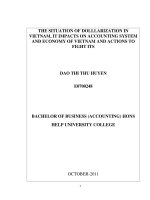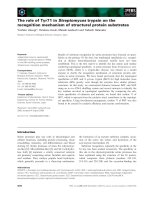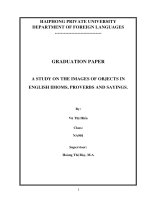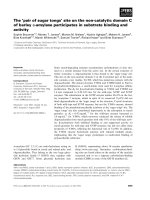The action of snake in venoms on surfaces film
Bạn đang xem bản rút gọn của tài liệu. Xem và tải ngay bản đầy đủ của tài liệu tại đây (761.8 KB, 8 trang )
L.
THE
ACTION
OF
SNAKE
VENOMS
ON
SURFACE
FILMS.
By
ARTHUR
HUGHES.'
From
the
Colloid
Science
Laboratory,
Cambridge.
(Received
December
23rd,
1934.)
THE
work
of
Kyes
[1902]
and
of
Kyes
and
Sachs
[1903]
showed
that
the
action
of
snake
venom
haemolysins
is
upon
the
lecithin
portion
of
the
cell
membrane.
Later,
Delezenne
and
Fourneau
[1914]
found
that
egg-lecithin
undergoes
a
partial
hydrolysis
by
snake
venom,
the
unsaturated
fatty
acid
residues
being
specifically
removed
to
form
lysolecithin,
which
contains
a
single
saturated
ali-
phatic
hydrocarbon
chain.
No
satisfactory
mechanism
has
been
suggested
for
this
specific
hydrolysis.
A
study
has
been
made
in
the
present
work
ofthe
actions
of
various
snake
venoms
on
unimolecular
films
of
lecithin
and
other
compounds
in
relation
to
the
processes
involved
in
venom
haemolysis.
As
opposed
to
the
study
of
reactions
in
bulk,
the
technique
of
surface
films
has
the
advantage
that
the
enzyme
substrate
can
be
studied
in
a
definite
and
reproducible
state,
that
of
an
oriented
monolayer.
Chemical
reactions
occurring
therein
are
observable
by
the
accompanying
changes
in
the
surface
potential
of
the
film.
The
surface
potentiometer
employed
has
been
described
elsewhere
[Schulman
and
Rideal,
1931].
Preliminary
investigation.
The
following
venoms
were
available:
COLUBRIDAE:
Black
snake
Pseudechis
porphyriacUs.
Copperhead
Denisonia
superba.
Black
tiger
Notechis
scutatUs.
Cobra
Naia
naia.
VIPERIDAE:
Daboia
Vipera
elegans.
A
film
of
lecithin
was
spread
on
the
surface
of
dilute
NaCl
solution
in
the
trough
of the
surface
potentiometer
and
compressed
to
a
fixed
reference
area
per
molecule,
usually
100
sq.
A.
A
dilute
solution
of
venom
was
then
injected
under
the
film
from
the
far
side
of
the
movable
glass
barrier
enclosing
the
film.
The
solution
was
well
mixed
and
the
change
of
surface
potential
was
measured.
In
cases
where
the
change
was
rapid
it
was
found
advisable
to
mix
the
venom
solution
in
the
trough
prior
to
spreading
the
film
to
ensure
uniformity
of
the
solution.
The
lecithin
film
is
spread
immediately
after
cleaning
the
surface,
since
protein,
which
is
always
present
with
the
venom,
accumulates
at
the
free
liquid
surface
in
the
more
concentrated
solutions.
With
a
venom
concentration
of
0.01
%
in
the
underlying
solution
a
rapid
fall
in
surface
potential
takes
place,
i.e.
in
the
direction
of
a
conversion
of
lecithin
into
lysolecithin
(cf.
Fig.
1),
in
the
case
of
all
the
venoms
except
cobra.
This
anomaly
of
cobra
venom,
ascribable
to
the
different
nature
and
greater
pro-
portion
of
associated
protein,
will
be
referred
to
later.
The
final
values
of
the
I
Beit
Memorial
Fellow.
(
437
)
surface
potential
of
a
lecithin
film
on
the
other
four
venoms
depend
on
the
degree
to
which
the
associated
protein
is
adsorbed
under
a
lysolecithin
film.
Thus
injection
of
venom
under
a
lysolecithin
film
causes
a
small
rise
in
potential
to
a
value
within
about
15
mv.
of
the
final
value
of
lecithin
on
that
solution.
400
Lcithin
300
<
|~~~~~~~
Fall
clue
'to
venonm
0
20C
___ys/L
olecithii
100
_ _ _ _ _ _
___
_ _ _
0
5
i
0
5x0'
mols./sq.
cm.
Fig.
1.
Surface
potentials
of
lecithin
and
lysolecithin,
0
9
%
NaCl,
180.
None
of
the
venoms
has
any.effect
on
a
unimolecular
film
of
cholesterol
or
of
protein,
and
they
cause
no
hydrolysis
of
tripalmitin,
triolein,
cerebron
or
sphingomyelin.
The
action
of
the
venom
on
a
lecithin
film
was
found
to
depend
on
three
main
factors:
(i)
The
PH
of
the
underlying
solution.
(ii)
The
surface
concentration
of
the
lecithin
film.
(iii)
The
venom
concentration.
These
effects
were
examined
in
detail.
(i)
The
effect
of
PH.
The
action
of
black
tiger
venom
was
studied
over
a
PH
range
from
4
to
11
using
M/25
phthalate,phosphate
and
borate
buffers
and
a
fixed
venom
concentration
of
0.001
%.
Fig.
2
gives
a
family
of
curves
showing
the
change
of
surface
potential
(A\V)
with
time
at
various
PH
values
for
a
definite
initial
surface
concentration
of
lecithin
(n=
1.0.
1014
mols./sq.
cm.).
There
is
no
reaction
on
solutions
more
acid
than
PH
4*8,
the
velocity
at
PH
6
0
is
about
equal
to
that
at
PH
8
0,
while
at
PH
10*8
the
reaction
is
again
strongly
inhibited.
The
optimum
is
at
about
PH
7-3.
The
venom
itself
is
stable
infairly
strongly
acid
media
but
not
in
alkaline.
After
keeping
for
3
hours
in
N/10
HCI
at
room
temperature
and
returning
to
PH
7-2
the
venom
solution
shows
unimpaired
activity.
Treatment
with
N/10
NaOH
for
the
same
period
destroys
the
venom
almost
completely
as
regards
its
action
on
a
lecithin
film.
The
action
is
not
inhibited
in
the
presence
of
0-5
%
NaF.
A.
HUGHES
438
ACTION
OF
SNAKE
VENOMS
ON
SURFACE
FILMS
(ii)
Effect
of
8urface
concentration8
of
lecithin.
The
rate
of
attack
of
a
lecithin
film
is
considerably
diminished
as
the
number
of
molecules
of
lecithin
per
sq.
cm.
is
increased
(Fig.
3).
The
time
for
complete
hydrolysis
of
the
film
increases
from
7
to
100
minutes
for
a
doubling
of
the
initial
surface
concentration
of
lecithin,
from
1-04
to
2-07.1014
mols./sq.
cm.
It
is
known
that
the
venom
specifically
re-
moves
the
unsaturated
hydrocarbon
chain
from
lecithin.
A
triolein
film
is
not
350
g
250
Mins.
Mins.
Fig.
2.
Fig.
3.
Fig.
2.
Influence
of
PH
on
attack
of
lecithin
films
by
black
tiger
snake
venom,
200.
Fig.
3.
Effect
of
compression
of
lecithin
film
on
attack
by
black
tiger
venom
(0-001
0).
A
n=2-11.1014
mols./sq.
cm.A
B
n
=
1-57.10'4
mols./sq.
cm.
p
C
n
=
1-27.1014
mols./sq.
cm.
PH
7-2,
170
D
n
=
1-04.1014
mols./sq.
cm.
hydrolysed
even
very
slowly
by
venom,
the
action
of
which
cannot
therefore
be
concerned
only
with
a
coupling
with
the
unsaturated
group
in
lecithin.
It
must
also
couple
with
some
other
point
in
the
lecithin
molecule.
Compression
of
the
leci-
thin
will
alter
the
spacing
of
the
essential
points
of
attachment,
and
at
the
higher
compressions
the
double
bonds
will
be
removed
from
the
aqueous
surface,
as
observed
in
the
case
of
oleic
acid
[Hughes
and
Rideal,
1933].
It
may
thus
be
suggested
that
the
lecithinase
embodies
also
a
spacing
of
two
active
groups
439
which
coincide
with
a
similar
spacing
of
two
active
groups
in
the
distended
lecithin
molecule
for
the
maximum
probability
of
reaction.
(iii)
Effect
of
venom
concentration.
Fig.
4
shows
the
rate
of
attack
of
a
lecithin
film
from
a
fixed
initial
surface
potential
of
280
mv.
by
varying
concentrations
of
copperhead
venom,
in
M/30
phosphate
buffer
at
PH
7-2.
It
is
seen
that
at
concentrations
higher
than
about
10-4
g.
venom
100
ml.
(1
partin
a
million),
the
reaction
is
of
zero
order
and
complete
in
5
minutes
at
200.
Below
this
concentration
and
down
to
the
lowest
concentration
used,
1
part
in
40
millions,
the
rate
of
reaction
falls
off
sharply
with
the
venom
concentration
till
at
2-5.
10-6
%
the
half
life
is
about
1
hour.
It
is
impossible
to
give
quantitative
values
for
the
velocity
constants
at
these
low
concentrations
owing
to
the
varying
amounts
of
protein
in
the
solution
and
the
possible
adsorption
of
the
venom
on
the
glass
vessel
as
well
as
at
the
surface
of
the
film.
It
must
be
remembered
that
the
values
of
the
venom
concentration
refer
to
dry
weight
of
crude
venom
scale,
and
that
the
fraction
of
this
which
is
pure
active
principle
is
unknown.
Attack
of
lecithin/cholesterol
films
by
venom.
The
rate
of
attack
by
black
tiger
venom
of
a
film
containing
20
%
cholesterol
molecules
is
the
same
as
that
for
lecithin
alone
at
the
same
area
per
molecule.
In
a
50
%
mixture
the
velocity
is
not
appreciably
diminished,
but
in
an
80
%
cholesterol
film
no
reaction
is
observed over
a
period
of
hours.
It
appears
that
cholesterol
has
no
specific
inhibitory
power
in
this
reaction
other
than
that
due
to
its
causing
a
general
contraction
of
the
lecithin
film
as
the
proportion
of
lecithin
is
decreased.
As
shown
in
Fig.
3,
a
similar
inhibition
is
observed
by
mere
compression
of
a
pure
lecithin
film.
Correlation
of
haemolytic
action
of
venoms
with
their
action
on
lecithin
films.
The
following
experiments
were
carried
out
to
ascertain
how
far
the
observed
changes
brought
about
in
a
lecithin
film
by
venom
were
ascribable
to
the
haemolysin
of
the
venom.
Washed
guinea-pig
cells
were
used
throughout.
In
Table
I
a
comparison
is
shown
of
the
effect
of
black
snake
venom
in
haemolysis
and
on
the
surface
potential
of
a
lecithin
film.
The
venom
solution
was
used
(a)
unboiled,
(b)
boiled
1
hour
in
saline,
(c)
unboiled
but
filtered
though
a
Seitz
filter.
Table
I.
1
ml.
5
%
cells,
1
ml.
venom
solution
(1
mg./ml.
in
saline)
at
37°.
Unboiled
Boiled
1
hr.
Unboiled
unfiltered
unfiltered
filtered
Haemolysis
C.H.
20
mins.
C.H.
20
mins.
N.H.
20
mins.
C.H.
40
mins.
Film
activity:
fall
of
46
mv.
41
mv.
22
mv.
AV
in
10
mins.
C.H.
=Complete
haemolysis.
N.H.=No
haemolysis.
These
figures
demonstrate
a
definite
relationship
between
hydrolysis
of
a
lecithin
film
and
haemolysis,
by
black
snake
venom,
and
further
show
the
remarkable
stability
of
the
venom
to
prolonged
boiling
in
saline,
a
point
which
is
discussed
more
fully
later.
A
more
complete
set
of
experiments
was
carried
out
using
four
varieties
of
venom:
copperhead,
daboia,
cobra
and
black
tiger,
while
a
definite
PH
was
main-
A.
HUGHES
440
ACTION
OF
SNAKE
VENOMS
ON
SURFACE
FILMS
tained
with
isotonic
phosphate
PH
7-4.
Control
experiments
on
the
isotonic
buffers
employed
showed
that
these
had
no
effect
on
the
fragility
of
the
cells.
The
system
for
haemolysis
was
made
up
as
follows:
1
ml.
of
venom
solution
in
isotonic
saline
(1
mg.
per
ml.),
1
ml.
isotonic
phosphate
buffer
and
0-5
ml.
of
5
%
washed
guinea-pig
erythrocytes.
The
venom
solution
was
used
(a)
unboiled,
(b)
boiled
10
minutes,
(c)
boiled
60
minutes,
the
heating
being
carried
out
at
PH
7-4.
It
was
immediately
noticed
that
the
cobra
venom
solution
on
heating
behaved
very
differently
from
the
other
venoms
in
giving
a
bulky
yellowish
white
precipitate,
whereas
the
other
solutions
only
showed
a
slight
opalescence
even
after
1
hour's
boiling.
This
and
other
anomalies
of
cobra
will
be
discussed
later.
The
main
results
were,
in
the
first
place,
that
ability
to
hydrolyse
a
lecithin
film
does
not
necessarily
imply
haemolytic
power
on
red
cells
of
any
given
species.
Thus
daboia
gave
no
haemolysis,
black
tiger
only
a
trace
after
16
hours,
while
copperhead
and
cobra
as
well
as
black
snake
were
strongly
haemolytic,
showing
complete
haemolysis
in
2
hours
with
a
concentration
of
0-2
mg./ml.
Secondly,
after
10
minutes'
boiling
at
PH
7-4
no
haemolysis
was
detectable
with
any
of
the
solutions.
This
result
in
comparison
with
the
results
shown
in
Table
I
indicates
that
the
heat
stability
of
the
venom
depends
on
the
PH
of
the
solution.
This
question
was
investigated
more
closely.
It
was
found
for
copper-
head
and
cobra
that
15
minutes'
boiling
at
PH
5*9
(phosphate)
has
no
effect
on
copperhead
and
only
a
slight
effect
on
cobra,
while
apparently
complete
de-
struction
ensues
at
PH
7
0
(phosphate)
and
at
PH
9
0
(borate)
(Table
II).
Table
II.
1
drop
50
%
cells,
1
ml.
venom
solution
(1
mg./ml.
in
isotonic
buffer)
incubated
at
37°.
for
2
hrs.
then
at
room
temperature.
PH
5-9
phosphate
7
0
phosphate
9
0
borate
Cobra
Unboiled
C.H.
3-3k
hrs.
C.H.
3-3j
hrs.
C.H.
11
hrs.
Boiled
15
mins.
P.H.
3-3j
hrs.
N.H.
N.H.
Copperhead
Unboiled
C.H.
ij
hrs.
C.H.
11
hrs.
P.H.
3-3j
hrs.
Boiled
15
mins.
C.H.
1i
hrs.
N.H.
N.H.
C.H.
=Complete
haemolysis.
P.H.
=Partial
haemolysis.
N.H.
=No
haemolysis
in
20hrs.
This
sharp
effect
Of
PH
on
heat
stability
has
not
previously
been
examined
and
may
account
for
varied
reports
as
to
the
influence
of
heat
on
different
venoms
[cf.
Phisalix,
1922].
The
experiments
with
surface
films
of
lecithin
revealed
further
that
where
complete
destruction
of
the
venom
is
registered
with
regard
to
haemolysis,
an
appreciable
quantity
of
lecithinase
may
still
be
present.
It
has
been
already
mentioned
that
a
concentration
of
venom
as
low
as
2-5.10-6
%
is
detectable
by
means
of
surface
potentials,
while
a
concentration
of
1-5.10-3
%
venom
only
produces
complete
haemolysis
in
16
hours
(cf.
Table
III
and
Fig.
4).
Table
III.
Effect
of
venom
concentration
on
haemolys8i
by
copperhead.
Conditions
as
in
Table
II,
PH
7
0
phosphate.
%
venom
10-1
5.10-2
2-5.
10-2
1.2.10-2
6-2.10-3
3.1.10-3
1.5.10-3
7-5.10-4
Time
1
hrs.
4
3 3
3
3
1
-
-
3t
hrs.
4
4
4
4
4
4
1
-
16hrs.
4
4
4
4
4
4
4
3
(4
represents
complete
haemolysis.)
441
442
A.
HUGHES
It
is
seen
that
at
a
concentration
of
7-5.
10-4
%
venom
haemolysis
is
not
yet
complete
even
in
16
hours,
whereas
a
lecithin
film
is
completely
transformed
in
3
minutes
by
the
same
venom
concentration.
The
method
of
surface
potentials
provides
therefore
a
very
much
more
sensitive
check
on
the
presence
of
a
lecithin-
ase
haemolysin.
300
150
0
lo
20
30
40
Mins.
Fig.
4.
Attack
of
lecithin
films
by
copperhead
venom,
PH
7
2,
200.
Venom
concentrations:
A
5
x
104.
B
I
x
1O4.
C
5
x
10-6.
D
1
x
10-5.
E
5
x
106.
F
2-5
x
IO-
The
surface
activities
of
venom
solutions
boiled
at
various
PH
values
were
compared
with
the
activity
of
the
same
venom
on
progressive
dilution
and
the
results
are
summarised
in
Table
IV.
The
quantity
of
undecomposed
venom
is
estimated
from
the
rate
of
attack
on
a
lecithin
film.
Table
IV.
Effect
of
boiling
on
the
lecithinase
content
of
copperhead
venom.
Initial
weight
of
venom
10-3
g.
PH
5.9
6-5
7*2
9-0
Boiled
for
15
mins.
10-3
10-3
ca.
10-5
nil
g.
venom
remaining
Boiled
for
60
mins.
10-3
ca.
10-4
ca.
10-
,
.
The
active
principle
of
the
venom
is
therefore
rapidly
decomposed
on
the
alkaline
side
of
a
sharp
PH
limit
of
6
5-7'0
and
boiling
for
15
minutes
at
PH
7-2
will
inactivate
the
venom
as
far
as
haemolytic
experiments
can
decide,
byreducing
the
venom
concentration
a
hundredfold,
although
this
small
quantity,
1O-5
g.,
is
still
readily
detected
by
the
method
of
surface
potentials.
The
complete
loss
of
surface
activity
as
well
as
haemolytic
activity
on
boiling
at
PH
9
0
seems
con-
vincing
evidence
of
the
close
relation
of the
two
effects.
An
attempt
was
made
to
examine
the
influence
Of
PH
on
the
rate
of
venom
haemolysis.
It
is
probably
impossible
in
some
cases
to
separate
the
effect
of
PE
from
that
of
the
buffering
ion.
For
cobra
and
copperhead
venoms
the
rate
of
attack
was
about
the
same
in
two
isotonic
phosphate
buffers
at
PH
5*9
and
7-0,
but
whereas
cobra
is
considerably
more
active
at
PH
9
0
(borate),
copperhead
is
considerably
less
so
(cf.
Table
II).
This
effect
of
PH
on
copperhead
haemolysis
supports
the
results
of
Holden
[1934]
that
rabbit
cells
are
haemolysed
more
rapidly
at
PH
5-6
than
at
PH
8-0.
ACTION
OF
SNAKE
VENOMS
ON
SURFACE
FILMS
443
The
anomalies
of
cobra
venom.
Three
different
specimens
of
cobra
venom
were
examined,
and
the
behaviour
was
found
to
be
uniformly
different
from
that
of
the
other
venoms
studied.
At
a
concentration
of
0.01
%
and
down
to
0.0001
%
cobra
venom
gives
no
detectable
hydrolysis
of
a
lecithin
film,
but
on
diluting
to
0
00005
%
(1
part
in
2.106)
a
slow
reaction
takes
place
as
in
the
case
of
the
other
venoms.
The
inactivity
of
cobra
venom
in
higher
concentration
is
possibly
related
to
the
protective
action
of
excess
of
this
particular
venom
on
the
haemolysis
of
erythrocytes
[Kellaway
and
Williams,
1933].
This
inhibition
occurs
to
a
negligible
extent
with
the
Australian
venoms.
It
is
possible
that
there
is
a
marked
preferential
adsorption
of
the
pro-
tein
portion
of
cobra
venom
on
a
lecithin
film,
and
at
a
concentration
sufficient
to
form
a
complete
layer
of
protein
at
the
surface
the
lecithinase
is
prevented
from
reaching
the
lecithin.
It
is
indeed
found
that
the
presence
of
such
a
quantity
of
cobra
venom
will
almost
completely
inhibit
the
attack
of
a
lecithin
film
by
other
normally
active
venoms
such
as
black
tiger
or
daboia.
Again,
addition
of
an
equal
weight
of
egg
albumin
to
black
tiger
venom
reduces
its
rate
of
attack
on
a
lecithin
film
tenfold.
Another
anomaly
of
cobra
venom
has
recently
been
stressed
by
McFarlane
and
Barnett
[1934],
namely
its
anticoagulant
action
on
plasma,
as
opposed
to
the
strong
coagulant
action
of
Russell's
viper
(daboia)
venom
and
certain
other
venoms.
It
is
significant
that
attempts
to
separate
the
toxins
from
the
coagulant
principle
in
these
cases
have
so
far
failed.
There
is
thus
a
possibility
of
a
close
relation
between
the
coagulant
and
the
lecithinase.
Pre-haemolytic
swelling.
In
cases
of
venom
haemolysis
a
large
pre-haemolytic
swelling
of
the
erythro-
cytes
is
usually
observed.
If
the
first
stage
of
haemolysis
is
indeed
the
liberation
of
lysolecithin
in
the
lipoidal
surface
layer
of
the
cell
membrane
one
would
anticipate
a
considerable
increase
in
area
since
the
area
per
hydrocarbon
chain
in
lysolecithin
films
is
nearly
double
that
obtaining
in
a
lecithin
film
at
the
same
state
of
compression.
The
more
expanded
nature
of
the
film
thus
formed
would
be
accompanied
by
an
increased
fragility
and
permeability.
SIUMMARY.
1.
The
physico-chemical
properties
of
snake
venom
have
been
examined
through
its
reaction
with
unimolecular
films,
particularly
lecithin
films.
Five
varieties
of
venom
were
studied:
black
snake,
black
tiger,
copperhead,
daboia
and
cobra.
2.
The
rate
of
hydrolysis
of
a
unimolecular
film
of
lecithin
to
lysolecithin
by
venom
lecithinase
is
dependent
on
PH,
surface
concentration
of
lecithin
mole-
cules
and
the
venom
concentration.
The
PH
optimum
is
about
7-3.
Compression
of
the
lecithin
molecules
greatly
decreases
the
rate
of
hydrolysis.
Venom
con-
centrations
as
low
as
1
part
in
40
millions
are
detected
by
the
method
of
surface
potentials.
3.
The
lecithinase
is
stable
to
prolonged
boiling
at
PH
5
9,
but
is
rapidly
destroyed
on
boiling
in
solutions
more
alkaline
than
PH
7
0.
4.
Haemolysis
conducted
concurrently
with
experiments
on
surface
films
shows
a
direct
relation
between
haemolysis
and
lecithinase
content
as
measured
by
rate
of
attack
on
a
lecithin
film.
5.
Anomalies
of
cobra
venom
are
discussed.
Biochem.
1935
xxix
29
444
A.
HUGHES
t
I
wish
to
acknowledge
my
indebtedness
to
Mr
E.
T.
C.
Spooner
for
his
in-
valuable
collaboration
in
the
experiments
on
haemolysis,
and
further
to
Dr
C.
H.
Kellaway,
whose
gifts
of
snake
venom
made
the
work
possible.
My
thanks
are
also
due
to
Prof.
E.
K.
Rideal
for
his
constant
interest
and
much
helpful
criticism.
I
am
indebted
to
Dr
Chain
for
fresh
specimens
of
egg-lecithin
used
in
the
above
experiments,
prepared
by
Levene's
method.
The
analysis
figures
were
3-96
%
phosphorus,
1*79
%
nitrogen.
REFERENCES.
Delezenne
and
Foumeau
(1914).
Bull.
Soc.
Cahim.
15,
421.
Holden
(1934).
Au8tral.
J.
Exp.
Biol.
Med.
Sci.
12, 55.
Hughes
and
Rideal
(1933).
Proc.
Roy.
Soc.
Lond.
A
140,
253.
Kellaway
and
Williams
(1933).
Au8tral.
J.
Exp.
Biol.
Med.
Sci.
11,
84.
Kyes
(1902).
Klin.
Woch.
Berlin,
39,
889,
918.
and
Sachs
(1903).
Klin.
Woch.
Berlin,
40,
21,
57.
McFarlane
and
Barnett
(1934).
Lancet
(ii),
985.
Phisalix
(1922).
Les
animaux
venimeux
et
les
venins,
2,
478.
Schulman
and
Rideal
(1931).
Proc.
Roy.
Soc.
Lond.
A
130,
259.









